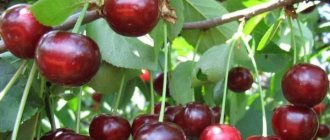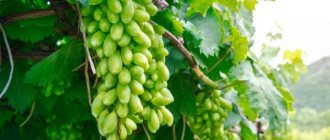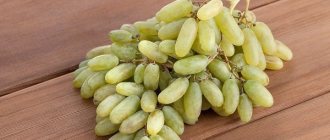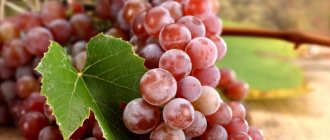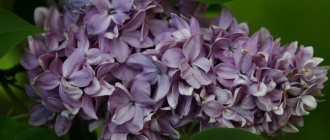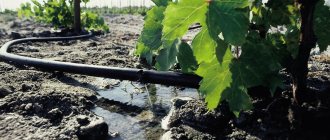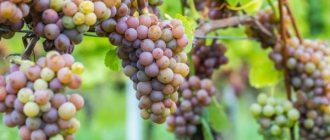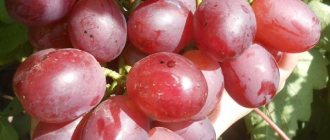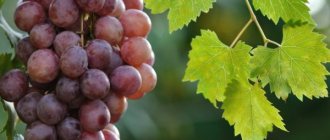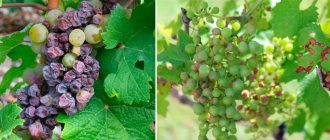Nadezhda Aksayskaya is one of the fairly new hybrid forms of white table grapes, obtained in the mid-2000s by the famous Don folk breeder Vasily Kapelyushny.
As a parent pair when breeding a hybrid, Vasily Ulyanovich used the magnificent Talisman variety, which was very popular among amateur breeders, with a functionally female type of flower, which was fertilized with pollen of the no less famous Arcadia. As a result of the selection of seedlings, the one that marked the beginning of the new variety was isolated. Its morphological properties turned out to be quite similar to those of its father. Because of this, some of the winegrowers suggested that there was no hybridization, and our heroine is the result of ordinary clonal selection, in which planting material from the best plants of the original variety is multiplied, and subsequently bushes with slightly improved characteristics.
Be that as it may, Nadezhda Aksayskaya, for all its external similarity with Arcadia grapes, demonstrates an earlier ripening period of the bunches, somewhat better resistance to frost and resistance to fungal diseases. And this is already enough for her to have the right to life and her own name.
Grapes Nadezhda Aksayskaya: variety description
The bush is medium tall. The bunch is very large, reaching even 2 kg, cylindrical-cone-shaped, dense, sometimes winged. The berry is large - 12-14 g, oval, golden-greenish. The skin is dense, moderately thick, and easy to eat. The pulp is juicy and crunchy. The taste is harmonious, revealing citrus, nutmeg and honey notes in the aftertaste.
The stalks are strong, strong, long, light green. The flower is hermaphrodite. The leaf is dark green, round, medium size, medium dissected. The ripened shoot is light brown with red-brown nodes, strong.
Descendant of Rizamat, Romeo and Gordey also have bisexual flowers.
Description
The trunk of the bush is strong and thick. Shoots can reach a length of 3 m. Their fruitfulness ranges from 75 to 90%. The bush looks attractive thanks to its large leaves. The five-lobed green leaf blade has dense arachnoid pubescence underneath. Flowers are bisexual. The grape bunch is large, loose, wide-conical in shape. Average weight - 0.5 kg.
The bunch of grapes of the Nadezhda AZOS variety is a little loose, but large
The berry is dark blue, almost black, elongated oval in shape, quite large - 6.2 g. The juicy fleshy pulp is covered with a dense skin with a waxy coating. The peel does not sour. The taste is very pleasant, tasters rate it 8.2 points. The sugar and acid content in the berries can be called almost balanced: sugar content - 14.4%, acidity - 10.2%.
Dark grapes are considered the healthiest and lowest in calories.
Characteristic
Features that distinguish Nadezhda AZOS grapes from other varieties:
- Nadezhda AZOS grapes are table varieties. It is preferable to eat it fresh. Not intended for winemaking;
- Fruiting is stable, increasing over the years. The average yield is 80 c/ha, the maximum is almost 2 times higher - 153 c/ha;
- medium ripening grapes. From the moment the buds burst until the onset of technical ripeness, 125–130 days pass;
- The grapes bloom in the middle or end of May. The harvest ripens in late summer. The berries do not fall off and can hang until the first frost without changing their taste;
- unpretentious, tolerates dry periods;
- frost resistance is average. The bush can withstand temperatures down to -22°C;
- resistant to a number of diseases, not susceptible to mildew and oidium. Moderately resistant to gray rot;
- due to its high taste and commercial qualities, it is one of the best commercial varieties;
- Nadezhda AZOS amazes with its precociousness - with proper care, the harvest can be harvested the very next year after planting. But experienced winegrowers recommend cutting off the early ovary so that the root system of the grapes can develop well;
- Nadezhda AZOS is quite aggressive towards its neighbors and does not get along well with other varieties. Exceptions are Codreaca and Moldova;
- cuttings root poorly;
- it is possible to overload the bushes with the harvest, the vine breaks under the weight of the bunches;
- under unfavorable weather conditions, pollination is poor, the berries grow small and the clusters are loose.
The Nadezhda AZOS grape has good characteristics that make it a popular variety
Table: advantages and disadvantages
| Advantages | Flaws |
| Excellent taste and appearance. | Poor pollination in bad weather. |
| Excellent early maturity. | During heavy rainfall, the berries may burst. |
| Stable yield. | Tendency to overload the bush and peas. |
| Good immunity. | Poor rooting of cuttings. |
| Good resistance to frost and drought. | |
| There is no need for pollinators. | |
| Thick skin increases transportability and keeping quality. |
Characteristics of grapes Nadezhda Aksayskaya
The variety grows well in all types of soil, so there is no need to prepare the site before planting the bush. The grapes take root well and grow quickly. Gardeners note good ripening of the grapevine even in the Northern regions.
Drought resistance, frost resistance
The hybrid can withstand temperatures down to -24°C well, however, the description of the variety states that Nadezhda Aksaya grapes are recommended to be covered for the winter at -15°C. The drought resistance of the variety is average. The grapes safely tolerate short-term drought, however, a long-term lack of moisture negatively affects its development.
Fruiting, productivity
The flowers of the variety are bisexual, so pollination occurs stably. Planting pollinators is not necessary. There are no signs of peas in the grapes; flowers and ovaries do not fall off. The yield of the bush is higher if the surface of the vine is covered with old wood.
The Nadezhda Aksayskaya variety matures in an average of 110-120 days. You don’t have to harvest the crop right away - the vine holds the berries well for some time.
Resistance to diseases and pests
The Nadezhda Aksayskaya grape variety has average disease resistance. The greatest danger to it comes from various kinds of fungi, so it is necessary to regularly spray the vine with fungicides.
Insects are rarely attracted to grapes. The main threat to the bush is wasps, from which they set sweet baits or cover grape bunches with mesh bags.
Advantages and disadvantages
The advantages of the Nadezhda Aksayskaya variety include the following characteristics:
- undemanding to growing conditions;
- early fruit ripening;
- pleasant taste of berries;
- attractive appearance of the fruit;
- high yield rates;
- no peas;
- good transportability;
- keeping quality;
- ability to withstand fairly low temperatures;
- average drought resistance.
Grapes also have disadvantages. These include:
- highly attractive to wasps;
- poor resistance to diseases, especially fungi.
Characteristic
The versatile grape Nadezhda Aksayskaya was bred by the famous amateur breeder from the Aksay district of the Rostov region V. U. Kapelyushny. The hybrid was obtained by crossing the common varieties Arcadia and Talisman. Observations of the new variety were carried out for 10 years, and then enthusiastic gardeners began to grow the new vine in different parts of the country, even in the Urals and Siberia. The frost resistance of the hybrid is -24 degrees. Winegrowers are happy to propagate table varieties that do not require special care, like Nadezhda Aksayskaya. Beginner gardeners can grow grapes. The bushes are productive, the harvest reaches up to 40 kg of sweet berries from one vine.
Depending on the region where the vineyard is located, the berries ripen in 110-120 days. The clusters hold the berries tightly and can be left on the vine for a longer period. The pleasant taste of the berries becomes sweeter and acquires nutmeg notes. Many gardeners believe that the berries taste like the Arcadia variety. The Nadezhda Aksayskaya grape vine ripens by more than two-thirds during the growing season. In addition to table purposes, the berries are used to create an exquisite bouquet of wine. The juice has a noticeable nutmeg aroma.
Features of the vine
This undemanding grape variety is grown on any soil: clayey, sandy, black soil. The cuttings root well. One-year-old seedlings are distinguished by a developed root system and active growth. A powerful vine requires rationing of shoots and inflorescences: no more than 35 eyes are left per bush. No peas are noted. The Nadezhda Aksayskaya vine has average resistance to common grape diseases, estimated at 3 points. It is necessary to carry out timely preventive treatments against fungal diseases. Also, Nadezhda Aksayskaya grapes have average resistance to wasps and phylloxera.
Important! Old wood contributes to higher yields and the formation of beautiful bunches.
Grape yield and ways to increase it
Nadezhda Aksayskaya grapes are characterized by high and constant yield. This is how reviews from gardeners describe it. One bush can produce a harvest of up to 40 kg, the shoots are characterized by good ripening, and the cuttings have high rooting ability.
Annual seedlings have good growth and a developed root system. High shoot ripening rates are achieved due to the powerful skeleton of the plant and vigorous bush.
The use of old wood by gardeners can significantly increase productivity and leads to the formation of large, beautifully shaped clusters.
In humid conditions, in order to prevent losses of grapes, it is recommended to carry out preventive spraying against the fungus, and during the growth process it is necessary to carry out rationing.
To maintain high yields, mandatory adjustment of inflorescences, shoots and bunches is necessary.
In addition, you should adjust the load on one bush at the level of 30-35 buds and perform timely pruning to 4.
The emergence of the Nadezhda Aksayskaya variety and its distribution
The N. Aksayskaya variety was created by Russian breeder V.U. Drop by artificial crossing of 2 varieties: Arcadia and Talisman. As a result of crossing, a plant with dark green leaves and beautiful, large and elegant cylindrical or conical clusters with a high density of berries was obtained.
Ripe shoots are colored light brown and have a strong structure; fruit peas are not observed. Testing of the new variety took about 10 years and was crowned with success.
Grapes have become widespread in almost all regions of Russia and have become very popular as a finished product and seedlings for planting. Thanks to the efforts of breeders, a variety was developed that is unpretentious to weather conditions and easy to grow.
Even beginning winegrowers can plant and breed it. Due to its high frost resistance, it can be grown in Siberia and the Urals, and in the conditions of the Moscow region. It grows and develops well outside greenhouse conditions, but in winter, at temperatures below 160C, it is recommended to cover it.
Landing Features
Nadezhda Aksayskaya grapes are unpretentious to soils; any soil will do - clay, sand, black soil. The seedlings have good survival rate. The vine has long, powerful roots, so you don’t need to water it often. You should choose a site for planting that is well-lit and not exposed to drafts, preferably near the wall of a building or next to a fence.
The vine can be planted in spring or autumn. Spring planting is preferable; the plant will have time to get stronger and grow before winter.
Landing is carried out according to the following scheme:
- Dig a hole 50 cm deep.
- A 10 cm layer of drainage is laid at the bottom of the pit. This can be broken brick, pebbles, or gravel.
- Next, a layer of earth combined with peat and sand is poured to a height of 10 cm.
- On top of the fertilized soil, ordinary soil dug from the hole is poured into a mound.
- A seedling is placed in the center of the hole and the remaining soil is carefully filled in and lightly compacted.
- Water the seedling abundantly and mulch the root circle.
- A frame is built nearby to support the vine.
Wine Chardonnay (Chardonnay) - what kind of grape is it, its full description with characteristics
Landing rules
Planting of Nadezhda Aksayskaya grape variety is carried out in spring or autumn, but it is better to do it in spring. This way, the planting material will have time to take root better before the onset of frost. It is recommended to place seedlings on the south side of residential buildings or outbuildings, as well as near the fence. This is necessary in order to protect the plant from strong winds. It is imperative to provide for the installation of a support; most often a trellis is used for this.
Landing algorithm:
- Planting holes are dug at a distance of 1-2 m from each other. The depth of the pit is 70-80 cm, width is 80 cm.
- At the bottom of the hole, place a drainage layer of about 10 cm, a mixture of humus and fertilizers in a ratio of 2:3. Azophoska (400-500 g) and wood ash (a 1-liter jar is enough) are used as fertilizers.
- After this, a support is installed next to the pit, to which the grapevine will subsequently be attached.
- The seedlings are carefully scratched from below. This way, the planting material will take root better. They are lowered onto fertilizers, deepening them well. The holes do not need to be covered with soil. Seedlings grow in a depression.
- Then the planting material is watered abundantly.
- It is recommended to complete the planting of grapes by mulching the hole. So, moisture will be better retained in the soil after watering.
Important! The thickness of the seedlings should be at least 8 mm, preferably 10 mm. They should have about 5 buds.
Reproduction
The crop is propagated by layering and cuttings; experienced gardeners and breeders prefer the method of propagation by grafting.
Layerings
This is the easiest method of propagation, which is suitable for the Urals and Siberia. To do this, choose a long and healthy vine. You can create no more than two layerings from one bush. This procedure is best carried out in the fall after harvest or in early spring, before the leaves bloom. After two weeks, the buried vine begins to take root from the nodes.
Step-by-step instructions for propagation by layering:
- If this procedure is carried out in the spring, a small groove 40 cm wide and 20 cm deep is dug next to the bush.
- A 6-centimeter layer of a mixture consisting of humus, complex mineral fertilizers and soil is poured onto the bottom.
- The selected vine is bent and placed in the prepared groove, secured with pins for reliability and sprinkled with earth on top. The top should rise above the ground.
- Water generously and cover with plastic wrap to ensure good rooting.
- Make sure that the soil is not dry and timely weed around the plant.
- The film is removed as soon as the first shoots grow.
- Then add a little earth on top.
- As the vine grows, it is tied up.
- If the mother vine is treated for diseases and pests, then the shoots also need to be treated.
- In the fall, if planting was done in the spring, carefully dig up the sprout and cut off each shoot with roots. Then they are placed in a dark and dry room for the whole winter.
- In June, these shoots are planted in a permanent place.
Cuttings
This method can be used in autumn or spring. For better rooting, it is advisable to plant in the spring:
- Annual cuttings with 6-7 buds are cut diagonally from the vine with a clean and sharp knife.
- The cuttings are soaked in water for about two days.
- Then they are planted in a pot filled with sand and soil.
- There should be at least 2 buds above the soil surface.
- Watering should be moderate, but the soil should not dry out.
- As soon as it takes root, it is transplanted to a permanent place on a warm and sunny day.
Reproduction methods
Nadezhda Aksayskaya grapes can be propagated in the following ways:
- By layering.
- By cuttings.
- Vaccinations.
The grafting method is not particularly popular; most often the crop is propagated through cuttings and layering.
Reproduction by layering occurs according to the following scheme:
- A healthy shoot from the bottom is separated from the vine.
- The end of the cutting is lightly buried and fixed on the ground.
- When the chained end has formed a root system, it is finally separated from the mother bush and replanted.
This method is carried out in regions with a short period of summer heat. When growing grapes on an industrial scale, it is ineffective, however, it is often used in private farms.
Advice! For better rooting of cuttings, it is recommended to separate no more than two shoots from the main vine. The optimal time for harvesting layering is March or early July.
Cuttings are harvested both in autumn and spring. In the second case, the planting material takes root better in the new location.
The procedure for preparing cuttings looks like this:
- Well-ripened annual shoots with 5-7 buds are carefully cut with a sharp knife.
- The resulting planting material is soaked in water for 2 days.
- After this period, the cuttings are planted in containers with a mixture of sand and fertile soil 2/3 of the total length. At least 2 buds should remain above the soil surface.
- The grapes are watered moderately from time to time. When the cuttings form roots, they are planted in open ground on a warm day.
Important! It is necessary to carefully treat the tool before cutting cuttings. To do this, wipe the blade with a cotton swab dipped in a solution of potassium permanganate.
Advantages and disadvantages
The Nadezhda Aksayskaya grape, due to its unpretentiousness and productivity, is becoming increasingly popular among gardeners. The advantages of this plant include:
- Excellent fruit taste.
- Aesthetic appearance of the bunch.
- Ripens in August.
- Easy to transport.
- Can be stored for a long time.
- High yield.
- Excellent frost resistance.
- Easily withstands drought.
Like any plant, it has disadvantages that can be overcome with proper care:
- Susceptibility to phylloxera and wasps.
- Predisposition to viral and fungal diseases in wet weather.
Taste characteristics and uses of grapes
N. Aksayskaya grapes have high taste qualities and a nutmeg aroma. It tastes like the popular Arcadia variety and is widely used in its natural form for making wines, desserts, juice, and homemade preparations. Winemakers use the berries of this variety when making bouquets of table wines. The juice squeezed from this type of grape emits a subtle muscat smell.
The grapes have a muscat aroma (photo of bunches)
The berries are juicy and fleshy, white-yellow in color of medium density, with a thin but strong skin that is not felt when consumed. The sugar content of the product is 16-18%, and the acidity is 6-7 g/l. The variety has the ability to be stored for a long time, both in harvested form and on the bushes. Due to this, the grapes can be left on the bushes much longer, which will make them sweeter.
Rules of care
- You can water this drought-resistant variety once a week with 2 buckets of water per bush. During flowering and before harvesting, watering must be stopped so that the vine does not drop its flowers due to excess moisture and the ripe berries do not crack.
- Fertilizing should be done in the spring, alternating mineral fertilizers with organic fertilizers at the rate of 1-5 liters per young plant and 5-10 liters per adult.
- Pruning is necessary for this grape variety; it is prone to overloading of branches. Pruning is done in spring and autumn. In the spring, damaged and broken shoots are pruned, and in the fall, pruning is done by 2-4 buds, leaving up to 35 buds on the bush.
- Mulching and loosening the soil of the root circle is carried out after each watering. It is also necessary to remove weeds in a timely manner.
- Considering the susceptibility of this variety to diseases such as powdery mildew, gray mold, phylloxera, and fungi, preventive spraying with insecticides is mandatory. Protective nets and special bags for bunches help against attacks by wasps and birds.
- For the winter, the grape bushes must be removed from their support, laid on a litter and covered with special material.
Aftercare
Caring for Nadezhda Aksayskaya grapes is not difficult. Particular attention should be paid to the load on the vine, since the grape bunches of the variety are quite heavy. If you do not normalize the bush, its branches may subsequently break under the weight of the fruit. The vine is stocked with shoots, inflorescences and clusters. In the first case, the recommended load for the variety is 30 eyes. If you overdo it with rationing, you can lose a significant part of the harvest. On the other hand, excessive load weakens the bush. Ultimately, he may die with the onset of cold weather.
Grapes are watered infrequently. The main thing is that the soil underneath does not crack from dryness. At the end of June it is recommended to thin out the vine. It is better to plant the ovaries on both sides of the bush. In the fall, the grapes are removed from their support and insulated for the winter with dry grass.
Plants of the variety are fed with compost in the spring months and humus in the fall. Fertilizers are applied no more than once every 3 years. An excess of nutrients negatively affects the development of the vine. Organics can be replaced with complex mineral fertilizers. The Nadezhda Aksaiskaya grape responds especially well to phosphorus fertilization when the leaves of the vine darken and begin to wither.
In spring, grapes are fed according to the following scheme:
- before the vine awakens;
- before flowering begins;
- during the period of fruit ripening.
Advice! If the bush rapidly turns yellow and the berries turn out sour, it means that the vine is experiencing a potassium deficiency.
Advantages and disadvantages
The rapid spread and growing popularity of Nadezhda Aksayskaya grapes indicate the advantages of the variety for growing in personal plots.
- Early ripeness;
- Rich taste of berries and attractive appearance of the bunch;
- High commercial performance of grape bunches;
- Keeping quality and transportability;
- High and stable yield of the variety;
- Relative resistance to gray rot, oidium and mildew (level 3 points);
- Drought and frost resistance.
Among the disadvantages of the Nadezhda Aksayskaya grape variety are:
- Sensitivity to phylloxera;
- Susceptibility to wasps;
- Prone to fungal diseases during prolonged rainy periods.
Growing Hope - Similarities and Differences
In planting and growing all three varieties of Nadezhda, there are common features and specific features of each variety.
Landing
Planting all three Hopes is no different from this operation for other grape varieties. Prepare the planting hole in advance. In 2–3 months, the soil in it will become compacted, and the roots of the grapes will not fall into the voids. A support stake is driven in the center into the hole, the diameter and depth of which, depending on the area where the grapes are planted, can be from 0.5 to 1 meter and filled in layers.
- On dense soils that do not permeate water well, the first layer to be made is a 10-centimeter drainage layer consisting of crushed stone or fine gravel with sand.
- Next, regardless of the soil, three layers are poured approximately the same thickness as the first: fertile soil, humus and fertile soil again. They are mixed thoroughly.
- The hole is filled with fertile soil, but not to the very top, leaving a depression for irrigation, into which 2-3 buckets of water are poured.
When the time comes to plant grapes, soil is chosen in the center of the prepared planting hole in such a way that the roots of the plant can be freely placed in the hole
They are spread out on an earthen mound filled inside, carefully covered with earth and compacted. Water the plant with warm water in a volume of 2-3 buckets
When the soil absorbs water, a layer of humus, sawdust, mown grass, and other organic matter is poured near the planted grapes. This is called mulch. It will protect the soil under the grapes from drying out and compaction during watering and rain, and, gradually rotting, it will become an additional fertilizer for the plant.
Since all three varieties of grapes under consideration have low winter hardiness, it is better to plant young plants in the spring.
Trimming
Autumn pruning of grapevines is one of the most important operations for:
- ensuring normal growth and development of plants;
- obtaining a decent harvest from them;
- preparing grapes for winter.
Although in general it is carried out according to the general rules for the formation of grapes, for each variety it has its own characteristics.
For Nadezhda, the EPA recommends short pruning, that is, 2–4 eyes should be left on the shoot; there should be no more than 45 of them on the bush.
It is recommended to cut Nadezhda Aksai into 2–8 buds per shoot and leave no more than 35 of them on the bush.
For Nadezhda early, a very young and not fully studied variety, no clear recommendations have been found; you should adhere to the general method of pruning grapes, taking into account that the bush is medium-sized.
Load regulation
All three Nadezhda grapes have large clusters. For their timely and high-quality ripening, and therefore for the berries to acquire a taste appropriate to the variety, and to prevent peas, it is recommended to leave no more than one bunch on the shoot. Although some experienced winegrowers, providing a high level of agricultural background, successfully grow two clusters. In any case, the number of bunches on the shoot must be normalized.
In addition, vines loaded with harvest must be well tied to the trellis so that the shoots do not break off.
Watering
As with other grape varieties, Nadezhda requires three mandatory waterings per season for successful growth and fruiting: before flowering, after flowering and after harvesting. In the periods between these stages of plant development, the need for additional watering is consistent with the weather of a particular season. In areas where winters are cold, so-called charging watering is often carried out in the fall after pruning the grapes and before covering them for the winter. It allows the plant to withstand frost more easily.
Disease Prevention
Of the three Nadezhda, Aksayskaya Nadezhda is the least resistant to major grape diseases. One or two preventative treatments with fungicides will only be beneficial for her. They are especially relevant in bad weather. They will not harm the other two Hopes in this situation. They are carried out during certain periods of the grape growing season:
- before flowers bloom;
- after flowering;
- when the developing berries reach the size of a pea.
Preparing for winter
All three Nadezhda have almost the same frost resistance. Therefore, when growing them for the winter, it is better to remove them from the trellis, bending them to the ground and wrapping them in hay, straw, and other covering materials. Polyethylene is fixed to the arcs on top of the covering materials, its edges are sprinkled with earth, leaving gaps for ventilation. In this form, the vines will be able to withstand winter cold.
You can remove the cover after the snow has completely melted. It is better to do this on a cloudy day or in the evening so that the spring sun does not burn the young shoots.
How to grow properly
Speaking about the agricultural technology of growing this variety of grapes, it is worth noting the following features:
- The landing site must be very well lit, and at the same time it must be protected from the wind.
- The soil in which the shoots will be planted should not be highly acidic. To reduce acidity, it is best to use lime. Sandy soils, clay-sandy soils, and black soil are good.
- For planting in the ground, petioles 8-10 millimeters thick are used.
- You can plant them on a hill, or in a hole.
Planting grapes
- In the first case, the earth warms up better, which entails greater productivity.
- In the second case, the plant is better protected from the effects of low temperatures.
- An interval of 1.8-2 meters should be maintained between neighboring seedlings.
- With the onset of late autumn, the grapes are covered, thereby preventing the vines from freezing.
- When fertilizing grapevines, it is worth remembering that 1-5 liters of fertilizer are enough for a young plant, and 5-10 liters for a mature plant.
- To increase the winter hardiness of a plant, it is necessary to cataractize the roots located on the surface.
Features of cultivation
To grow this varietal grape, there is no need to fully study agricultural technology; it is enough to have only general knowledge. The main thing is to provide the crop with proper care, which consists of timely feeding, watering and pruning.
Grapes in a greenhouse
Tason grapes should be planted in open ground with plenty of light without drafts, and so that groundwater does not pass close to the future vineyard. You need to add 1 bucket of manure or chicken droppings into the hole under the seedling. Make a drainage so that the water does not stagnate (crushed stone or broken brick will do), sprinkle it with soil, making a small slide in the hole. A seedling is placed on it, the roots straightened, and covered with the remaining soil. They compact the stem a little and water it (1 bucket of water per 1 bush).
The first year it is important to control soil moisture and water more often on hot days. The ground under the bush can be mulched (sawdust, straw or dry grass)
Important! You can prune Tason in the first year, when the seedling begins to grow. It is allowed to pin the top of his head to form sleeves
During pruning, no more than 7 shoots should remain on one vine.
Reviews
Ivanov Dmitry, 24 years old, Tula region
My father and I have been growing the unpretentious Nadezhda Aksayskaya grape for several years now. Since in winter the air temperature in our country can drop below -25°C, we must cover the plants for the winter.
We propagate by cuttings. During the entire period of cultivation on the crop, insect pests were never noticed. We annually spray the entire top for fungal diseases. Every year we harvest a huge harvest. In productive years, one bunch can weigh at least 1.5 kg. Excellent variety!
Safronova Tatyana, 43 years old, Rostov region
Nadezhda Aksayskaya planted grapes at her dacha and never regretted it. The fruits taste amazing, look beautiful, withstand transportation well and do not burst, which is important for me, since I grow them for sale. The berries of this variety sell out faster than others. This year I plan to plant several more seedlings of this variety.
Aksenov Roman, 46 years old, Volgograd region
Four years ago, my friend shared a cutting of the Nadezhda Aksayskaya grape variety. In the third year, my wife and I picked the first berries from the vine.
We were surprised by their great taste! And what surprised him even more was the abundant yield. We even managed to sell several kilograms of the crop. After that, he gave a cutting to his brother in the Saratov region so that he, too, could have his own grapes.
Meet the Three Hopes
Each of the Hopes is special and good in its own way. Two of them are brunettes - AZOS and early - black grapes, Aksai - a bright blonde - white grapes.
Nadezhda AZOS
Nadezhda AZOS, bred at the Anapa zonal experimental station of viticulture and winemaking, is widely known and popular among winegrowers. Only this one out of three passed tests at the Federal State Budgetary Institution “State Varietal Commission” and in 1998 was included in the state register as recommended for cultivation in the North Caucasus. Its originator is the North Caucasus Federal Scientific Center for Horticulture, Viticulture and Winemaking.
Nadezhda AZOS was bred from a parent pair of the Cardinal and Moldova grape varieties, well-known and popular among winegrowers.
What Nadezhda AZOS and her parents look like - photo
Grapes Nadezhda AZOS
One of the varieties of the parent pair of grapes Nadezhda AZOS
Grapes from a parent pair of Nadezhda AZOS grapes
It has a table purpose. The grapes grow on strong, tall bushes. This Hope has flowers with functions of both sexes. The bunches ripen in an average period of 120–130 days. They are large and branched. Their average weight is about 0.5 kilograms. The dark, almost black oval grapes are loosely collected and weigh from 6 to 8 grams. They are covered with a thick, crispy skin. Fleshy pulp filled with juice with a simple pleasant taste is sweet and sour - it contains 14% sugar, about 10 g/l acid. She earned a taster rating of 8.2 points. Nadezhda AZOS produces good harvests. From one hectare of vineyard you can get from 80 to 153 centners of fruit. This dose is very little susceptible to powdery mildew (powdery mildew and mildew), and the resistance to gray rot is average.
The best fruiting of Nadezhda AZOS was recorded when it was grown on a vine formed as a single-arm cordon. The vine trunk is formed 110–120 centimeters high, and the shoots are left hanging freely.
It is recommended to load the bush with 25–30 shoots, which are cut short in the fall, leaving 2–4 eyes.
Nadezhda AZOS is not very adapted to withstand winter cold. Temperatures below -22 ºС are destructive for it. In areas with harsh winters, it must be carefully covered.
Nadezhda AZOS - video
Reviews about the Nadezhda AZOS variety
I got Nadezhda AZOS a very long time ago, when it was not just a shortage, but few people knew that it existed... The manager gave it to me.
Anapsky GSU Brodenko Anatoly Afanasyevich. My Rusbol was growing by that time, and after seeing the harvest and berries for 2 years, I decided to regraft it with Nadezhda AZOS. On Rusbol it turned out completely different, the berry is very large (if on a drop with feeding it is not inferior to the Monarch), the clusters are large up to 3200 g, the harvest reaches up to 45 kg per bush (planting pattern 2.5 m by 2.5 m, single-row trellis), True, the ripening period increases, depending on watering. It also happened on September 20th. Yuri45
https://lozavrn.ru/index.php?topic=63.0
Nadezhda Azos - opening of the season/year.
Very, very sweet, the consistency of the pulp is marmalade, but it lacks sourness for me. Vladimir_
https://forum.vinograd.info/showthread.php?t=210&page=240
I am a beginner winegrower.
This year I received the first bunches of Azos. They colored early and became tasty only in September. Everyone liked the pulp and taste. Stored well. In the spring, I cut a cutting into two buds and stuck it in the ground between two bushes - it took root (under the eggplant) and is growing. What else do you need, an awesome variety. At the end of August I went to one of the grape varieties to try. Of the many vaunted varieties, there is no taste, or the wasps are striking (blagovest). So for now I will consider Azos one of my main varieties. S_ivanickiy
https://lozavrn.ru/index.php?topic=63.0
Nadezhda Aksayskaya
Aksayskaya Nadezhda was created by the most talented Don grape breeder and farmer Vasily Kapelyushny, who, unfortunately, left us in May 2021.
Aksayskaya Nadezhda was created by the most talented Don grape breeder and farmer Vasily Kapelyushny
Vasily Ulyanovich received Nadezhda Aksai from the wonderful parents of Talisman and Arkadia.
What Nadezhda Aksayskaya and her parents look like - photo
Grapes Nadezhda Aksayskaya
One of the parent varieties of Nadezhda Aksayskaya
One of a pair of parent varieties of Nadezhda Aksayskaya
The resulting grapes are table grapes, tasty, and when fully ripened in 110–115 days, exhibit a light muscatel quality. Bushes whose flowers are bisexual give their strength not so much to the growth of shoots as to the cultivation of loose clusters. They ripen large and even very weighty - 700–1200 grams, or even 2 kilograms. They can remain on the bush for a long time, only becoming sweeter.
Oblong yellow-green grapes, their components are not small - 8–12 grams each. The skin of the berries, although dense, is not noticeable in food. The sour-sweet taste of the Nadezhda Aksayskaya grape variety is determined by 16–18% of the sugar accumulated by the berries and 6–7 grams of acid per liter of juice.
The originator tested his variety for ten years on one hundred bushes. He harvested up to 40 kilograms of harvest from an adult vine. This result can be obtained by normalizing the number of shoots on a bush, inflorescences and clusters on each of them. Then the yields will be stable.
With annual autumn pruning, 2–4 eyes are left on the shoots, and up to 35 eyes in total on the bush.
The shoots of Nadezhda Aksai ripen well, but the vines can withstand the winter cold only down to -23–24 ºС. It is recommended to protect this variety from frost if temperatures below -16 ºС are likely in the area where it is grown.
The variety is only relatively resistant to both types of powdery mildew and gray mold, so one or two preventive treatments are recommended throughout the season, especially if the year is rainy.
Nadezhda Aksaysay - video
Reviews from winegrowers about the Nadezhda Aksayskaya variety
Nadezhda Aksai has a light nutmeg taste and at the first fruiting there were 4 clusters on the bush and they looked like the end of July.
Personally, based on the first indicators, my opinion is worth changing. The vine of this form has fully matured. and ARKADIA (Nastya) has half.) Let's see what happens next if you believe KAPELYUSHNY VASILY ULYANOVICH, he has had this form for 10 years and has planted up to 150 bushes. Is it possible to instill bad things? PETER
https://forum.vinograd.info/showthread.php?t=934
Good health to everyone!
On August 2, 3 and 4 she visited the Kapelyushnys. I looked through and tried all the grapes. NADEZHDA AKSAYSKAYA is fully ripe, wholesalers take it with pleasure - bunches of more than 2 kg, beautiful color, excellent taste. ARCADIA on the same site is not yet ready. I was convinced once again that you need to believe in yourself. Good luck to all. janina
https://forum.vinograd.info/showthread.php?t=934&page=2
Early hope
These grapes have a very early ripening period of 95–100 days and were bred not so long ago by the Dnieper amateur breeder Anatoly Golub. He already has several dozen varieties of grapes in his arsenal.
Anatoly Alekseevich received Nadezhda early from a wonderful pair of varieties ZOS-1, which is also called ZOSEY or Red Delight, and Nadezhda AZOS
I have been growing grapes for more than 20 years.
I started breeding 7 years ago. I set a goal to select from new hybrid forms varieties that are not damaged by wasps and are resistant to cracking when the soil is waterlogged, G.F. with very large berries and good harmonious taste. In the process of seven years of work, only a few hybrid forms were selected from a large number of seedlings that met my requirements. The seedlings were grown in spartan conditions, in open ground. No growth stimulants were used. No agrotechnical measures were carried out. I am pleased with the results I have received over the years! All berry sizes are real and in a high agricultural background the berries and clusters will be even larger. A.A.
Golub https://vinogradnik-skitenko.narod.ru/katalog_goluba.html
Anatoly Alekseevich received Nadezhda early from a wonderful pair of varieties ZOS-1, which is also called ZOSEY or Red Delight, and Nadezhda AZOS.
What the grape family of Nadezhda Early looks like - photo
One of the varieties of the parent pair Nadezhda early
Early hope
One of the grapes of the parent couple Nadezhda early
Their brainchild, Nadezhda Early, turned out to be so productive that the load of the bush in clusters must be normalized. In addition, she is practically not afraid of wasps and powdery mildew. Its resistance to phylloxera is somewhat lower. Early Nadezhda is not very resistant to cold weather, only -23–24 ºС, so it can only be grown in areas with freezing winters using a covered method.
Grapes respond well to timely watering and fertilizing, but prefer fertilizers with a low nitrogen content.
Early Nadezhda is a hybrid form of grape with dark colored berries. Its medium-sized bushes have bisexual flowers, so there are no complications with pollination. Winged large clusters of Nadezhda reach a kilogram and even more weight. Oval dark blue elongated berries, covered with purine, are arranged freely. They can weigh up to 14 grams. Grapes filled with juice are covered with a moderately thick, dense skin, which is eaten when eaten. The taste of the berries is pleasant with fruity nuances. The grapes do not crack, are not damaged by wasps, and thanks to their thick skin, they can remain on the vine for a long time, gaining additional sugar. The harvested crop is well stored, does not spoil, and is easily transported.
Nadezhda early is resistant to common ailments of grapes, as well as to most pests.
Early Hope - video
Reviews from winegrowers about Early Hope
Early Nadezhda - a hybrid form of grapes - very early ripening, in 2008, ripe on July 26.
It hangs on the bush for a very long time without losing its marketable qualities. The berry is large and very large, ovoid-oval, with a pleasant simple taste. The pulp is fleshy and juicy, the black taste lasts until autumn. Not prone to cracking and not affected by wasps. No peas were observed during fruiting. The flower is bisexual, the stability during observation is good, the yield is stable. High. The pulp is black. Several tones in taste. Hangs without losing taste until frost. Vitaly
https://forum.vinograd.info/showthread.php?t=1003
Diseases and pests
Nadezhda Aksaiskaya definitely needs preventive spraying against powdery mildew - mildew and oidium, as well as gray rot.
They are very dangerous for grapes - all parts of the bush suffer, the berries become unusable - you can no longer make compote or wine from them, much less eat them. Diseased shoots and leaves are separated, otherwise your product will acquire a distinct moldy taste.
Spraying with chemicals helps against powdery mildew - such as Bayleton, Rubigan, Karatan, Bi-58, Topaz, Strobi, Quadris.
Another enemy of vineyards is gray rot. Omite, Rovral, Bordeaux mixture, Ridomil-Gold are used against it.
Phylloxera may also appear. And then you will have to work hard: it is not at all easy to remove the parasite. Only spraying with flammable carbon disulfide is effective against it - 300-400 cubic centimeters per square meter. You can reduce the dose a little, but not less than 80 “cubes” - otherwise all your efforts will be in vain, the parasite will certainly return. True, this remedy can equally kill the bush itself, but the bush is better than the entire vineyard.
You should not avoid preventive measures against such common diseases as anthracnose, chlorosis, bacteriosis, rubella and bacterial cancer.
Against this background, the fight against wasps looks quite simple - just pack the bunches in mesh bags and destroy all the nests found. With birds it’s even easier - install a rigid net and you can forget about the problem.
Just don’t put up a rope if you don’t want, in addition to grapes, to have a regular “harvest” in the form of dead, beating and screaming birds. All you have to do is keep them out of the vineyard, not kill them.
Nadezhda Aksayskaya remarkably withstands Russian winters, resists diseases and gives the owner an abundant, wonderful harvest.
You just need to help her with this a little - follow very simple measures for the prevention of fungi, which are part of the arsenal of any gardener.
Agrobiological characteristics
Plants of medium vigor. The leaves are large, stretched wide with raised edges, mostly five-lobed, slightly dissected. The surface of the leaf blade is net-wrinkled, the color is rich green with light veins. The upper lateral notches are weakly marked or have a V-shape, the lower ones are most often absent. The petiole recess is usually open, vaulted, with a flat or pointed bottom, sometimes lyre-shaped. The petioles are long, light green with barely noticeable anthocyanin pigmentation. The teeth along the perimeter of the grape leaf are medium-sized, mostly triangular with smooth edges and pointed apices. The flowers of the variety are bisexual, and therefore pollination occurs quite stably; there are no signs of noticeable peas, shedding of flowers or ovaries. The shoots of the current course ripen well, often to their entire length. The color of the ripened vine changes to light brown at the internodes, and darker at the nodes. The autumn color of the foliage of Nadezhda Aksayskaya is yellow.
The clusters grow large and very large in size, their average weight is 800-1100 grams, but there is evidence of outstanding specimens weighing up to 4 kg. The shape of the brushes is wide-conical, the density is from moderate to quite high. The comb is not too long, but thick and strong, pale green in color, sometimes with a pinkish area at the base. The grapes are massive, magnificent in size and shape. The length of oblong or ovoid grapes is 26-28 mm, diameter - 22-23 mm, weight 8-12 grams or more. The color is greenish-white with a slight light waxy coating on the surface. Despite the rather dense structure of the bunch, the berries in it are not subject to deformation or damage against each other. The evenness of the grapes among themselves is, as a rule, quite good. The pulp is dense, juicy and fleshy, has a harmonious, moderately sweet taste, and a pleasant nutmeg aroma that appears after full ripening. The juice is colorless, sugar content 16-18 g/100 cubic meters. cm, and a titratable acidity of 5−6 g/cubic dm. The skin is of medium thickness, quite durable, although easily eaten. The seeds are small, 2-3 in number, and they do not have a significant negative effect on the taste characteristics. The overall tasting ratings of the variety are excellent.
The grown crop of Nadezhda Aksayskaya is used with great success for fresh consumption. Obtained early and with excellent visual appeal, it finds a wide range of true connoisseurs, and is in high demand on the market among buyers who perceive it as Arcadia. At the same time, farmers may like it because it ripens 6-8 days earlier than Arcadia, and therefore can hit the shelves before the massive influx of competitors. Sales opportunities are significantly expanded due to the ability to transport the collected bunches. without loss in quality, over long distances, thanks to their excellent transportability. The variety's suitability for storing crops is also quite high, which makes it possible to significantly extend the period of its consumption. In addition to being used directly for food, grapes can be successfully used as a raw material for the production of light and aromatic juices and compotes, as well as very tasty preserves and jams. Its processing is especially often practiced in households, where abundant harvests from even several bushes are unrealistic for members of the same family to consume fresh.
The beginning of ripening of bunches in the south occurs in the first ten days of August. 110−115 days after bud break, harvesting can usually begin. Thanks to such a short growing season, the variety falls into the category of early ripening, and can be successfully cultivated in the middle zone of the country, where the grape harvest will ripen well, even if the harvesting time shifts closer to autumn. The sum of active temperatures required during the season by Nadezhda Aksaiskaya is 2300−2400°C. A similar level of heat supply is typical for cities such as Kaliningrad, Kaluga or Ryazan, so this line can be considered the northern border of its cultivation. When promoting a culture to the north, one should not forget only about the frost resistance of the grapevine. In this variety it may be elevated (-23...-24°C), but it is sufficient for uncovered cultivation only in the south, in traditional viticulture regions.
The productivity of our heroine is very high. According to the author, he managed to achieve a figure of 35-40 kg of grapes per bush. However, such records, without fatal overload for the plant, are possible only with the highest level of agricultural technology and on powerful formations with a large supply of old wood. Under normal conditions, a good result would be a productivity of about 15-20 kg, at which the risk of Nadezhda Aksayskaya being overloaded is minimized. In this regard, the variety requires careful rationing of the load of eyes, shoots and yield, in which the winegrower must take into account genetically determined indicators, such as: a high percentage of fruitful shoots, a significant number of inflorescences laid on them, and outstanding large fruit. If you do not take action to limit the excessive potential yield of the form, then the likelihood of weakening of the bushes and their death in winter increases significantly.
After the onset of removable ripeness, the grape bunches can remain on the vine for some time, during which some more sugars will accumulate in the berries, and the characteristic muscat aroma will appear with greater force. The variety is moderately prone to cracking of berries; a similar problem appears only under very negative weather conditions. Damage by wasps to sweet and aromatic overripe berries occurs more often, but there are a significant number of simple but reliable methods for protection against annoying insects.
Fertilizer
Every three years the crop must be fertilized with compost and humus. The first is given in the spring, and the second at the end of autumn. During the season, the crop is given complex mineral fertilizers several times:
- In early spring, as soon as the leaves begin to bloom.
- Before the flowers appear.
- During fruiting.
If the leaves begin to fade slightly and darken, then the plant does not have enough phosphorus. With a lack of potassium, the green mass begins to turn yellow in early August, and the berries taste bland.
Agrotechnical features
Cultivating Nadezhda Aksayskaya should not cause any particular difficulties for people who are familiar with at least basic knowledge of viticulture technology. As already mentioned, the variety exhibits many similarities with the paternal form of Arkady, which means their agricultural technology should be very similar.
The vineyard is located in areas that are provided with the most heat and sunlight, which is especially important when growing it in the middle zone, outside traditional viticulture zones. To do this, they try to select places in the upper part of the southern slopes, and in personal plots they plant bushes in a wall culture under protection from cold winds with the help of various buildings or permanent fences
In regions with a sufficient level of SAT, such recommendations are not important; here the variety grows well and manages to ripen even in open flat areas. However, there are also certain generally accepted limitations. In particular, grapes should not be planted on slopes with northern exposures, in lowlands of ravines and valleys where cold air stagnates, as well as on excessively damp soils and places with shallow groundwater.
In areas where the soil is infected with root phylloxera, the variety is propagated using grafted seedlings on phylloxera-resistant rootstocks. In areas where the malicious soil pest has not yet penetrated, excellent results are shown by rooting the cuttings of the hybrid itself and their subsequent planting in a permanent place. In the latter case, the bushes also develop faster, usually entering fruiting a year earlier than the grafted plants. The feeding area for medium-sized grapes, which includes our heroine, should be about 4-5 square meters. meters, depending on local conditions.
Systems for maintaining bushes can be different, depending on the frost danger of the climate and, accordingly, the need to cover the vines for the winter. In the southern regions, with a minimum probability of cold weather greater than -23°C, Nadezhda Aksayskaya can be formed on a high trunk, which will have a positive effect on the large fruit size and quality of the crop, due to the large reserves of plastic substances in the volume of perennial wood. However, even with a slight movement of the hybrid form of grapes to the north, the use of covering forms, such as a multi-armed fan or an inclined cordon, will be required.
Plants begin to bear fruit for 2-3 years, after which there is a need for careful annual rationing of shoots and yield to prevent overload, to which the variety has a significant tendency. In spring, fruit shoots are pruned into 3-5 buds, due to their high fruitfulness at the base of the shoots, and the bushes themselves are loaded with 30-35 buds. Subsequently, the weak and fruitless shoots of the grapes are broken off, leaving no more than 20-22 fruit-bearing vines, and on each of them the excess inflorescences are removed, except for one - the largest.
The ability of the bushes to bear the load, and at the same time the yield indicators, can be significantly improved if you regularly water the vineyard and fertilize it with mineral fertilizers in moderate doses. Maintaining an optimal water regime in the soil will also be useful from the point of view of preventing cracking of Nadezhda Aksaiskaya berries during ripening.
To combat fungal infections, 2-3 preventive complex treatments of the variety with fungicides will be required in the early stages of the growing season, followed by careful monitoring of the phytosanitary condition of the grape plantings.
Back and forth

